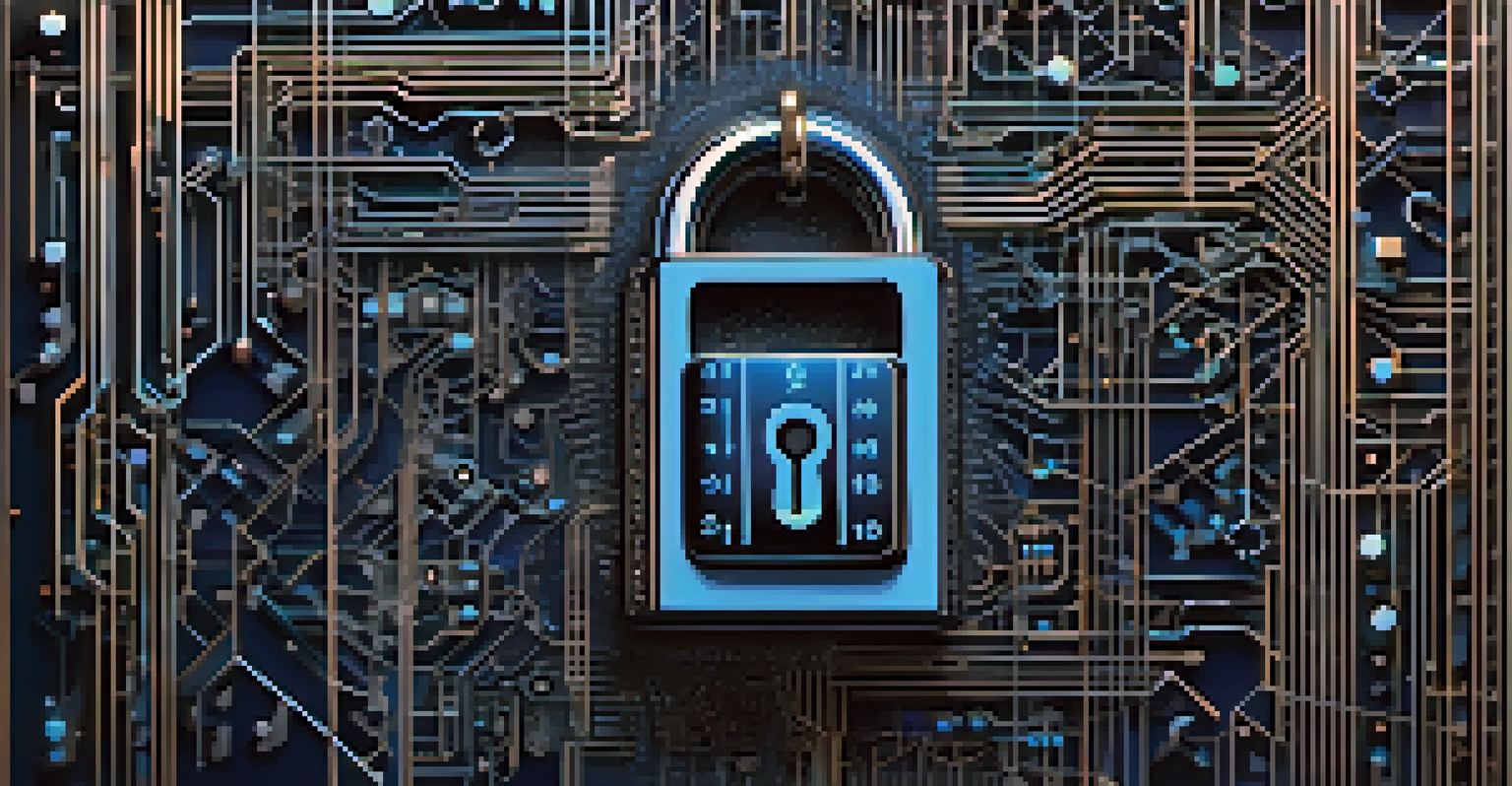The Future of Cybersecurity: Trends to Watch in 2024

Increased Focus on AI and Machine Learning in Cybersecurity
As we look ahead to 2024, artificial intelligence (AI) and machine learning are set to play pivotal roles in cybersecurity. These technologies can analyze vast amounts of data at lightning speeds, detecting anomalies that might indicate a breach. For example, AI can learn from previous attack patterns and adjust defenses in real time, making systems smarter and more responsive.
Cybersecurity is much more than an IT topic; it’s a business issue that requires the attention of the entire organization.
However, while AI can enhance security measures, it also poses new threats. Cybercriminals are increasingly leveraging AI to create sophisticated attack strategies, such as automated phishing campaigns that are harder to spot. This cat-and-mouse game between security teams and attackers highlights the importance of staying updated on AI developments.
Related Resource
In essence, the integration of AI into cybersecurity may transform how we defend against threats, but it requires continuous vigilance and adaptation. As technology evolves, so too must our strategies, ensuring that we’re not just reacting to threats but anticipating them.
The Rise of Zero Trust Security Models
Zero Trust has become a buzzword in cybersecurity, and it's a trend that's here to stay in 2024. The core principle of Zero Trust is simple: never trust, always verify. This means that, regardless of whether a user is inside or outside the organization’s network, they must authenticate themselves before accessing resources.

Implementing a Zero Trust model can significantly reduce the risk of data breaches. For instance, if an attacker gains access to a network, they won't have unrestricted access to sensitive information without additional layers of verification. This approach resembles the security measures of a high-security facility, where access is tightly controlled and monitored.
AI Enhances Cybersecurity Measures
Artificial intelligence and machine learning are pivotal in detecting anomalies and adapting defenses in real-time.
As organizations increasingly adopt this mindset, we can expect to see more sophisticated tools and technologies that support Zero Trust frameworks. The transition may be challenging, but the enhanced security posture is worth the effort.
Growing Importance of Cyber Hygiene Practices
In 2024, the emphasis on 'cyber hygiene' will be more critical than ever. Just as we practice good hygiene to prevent illness, maintaining robust cybersecurity practices can help organizations avoid breaches. This includes regular software updates, strong password policies, and employee training on recognizing phishing attempts.
The greatest danger in times of turbulence is not the turbulence; it is to act with yesterday's logic.
Consider a small business that implements regular cybersecurity training for its employees. This proactive approach not only empowers staff but also creates a culture of security awareness. Just like washing hands can prevent the flu, simple cyber hygiene steps can drastically reduce the risk of a cyber incident.
Related Resource
Ultimately, fostering a culture of cyber hygiene can be the first line of defense against evolving threats. By prioritizing these practices, organizations can build resilience and better protect their valuable data.
Increased Regulation and Compliance in Cybersecurity
As cyber threats become more sophisticated, regulatory bodies are stepping up to enforce stricter compliance measures. In 2024, organizations will need to navigate an even more complex landscape of cybersecurity regulations, such as GDPR and CCPA. Complying with these regulations isn’t just about avoiding fines; it’s also about building trust with customers.
For example, companies that transparently communicate their data protection strategies can enhance customer confidence. Just as a restaurant earns trust through cleanliness and quality, businesses can foster loyalty by demonstrating their commitment to protecting personal information.
Zero Trust Security Gains Momentum
The Zero Trust model emphasizes continuous verification of users, significantly reducing the risk of data breaches.
Navigating the regulatory landscape can be daunting, but it also presents an opportunity for organizations to strengthen their cybersecurity posture. By proactively addressing compliance, businesses can not only avoid penalties but also differentiate themselves in the marketplace.
The Expansion of Cloud Security Solutions
With more organizations migrating to the cloud, cloud security solutions are becoming a focal point in cybersecurity discussions for 2024. As businesses rely on cloud services for everything from data storage to application hosting, ensuring the security of these environments is paramount. This shift is akin to moving from a traditional storefront to an online shop; the security measures must adapt accordingly.
Cloud security solutions often include advanced features such as encryption, identity and access management, and real-time monitoring. These tools can help organizations protect their data and respond to threats swiftly. Just as a good alarm system can safeguard a physical store, robust cloud security measures can protect digital assets.
Related Resource
As cloud adoption continues to rise, we can expect innovations in cloud security to keep pace. Organizations that leverage these solutions will be better positioned to safeguard their information and maintain business continuity.
Emphasis on Incident Response Planning
As cyber threats continue to evolve, having a robust incident response plan is crucial for organizations in 2024. An incident response plan outlines the steps to take when a security breach occurs, allowing teams to react quickly and effectively. Think of it as a fire drill; practicing responses can save time and minimize damage in a real emergency.
For instance, a well-prepared organization can limit the impact of a data breach through swift containment measures and clear communication strategies. This proactive approach can turn a potential disaster into a manageable situation, safeguarding both assets and reputation.
Importance of Cyber Hygiene Practices
Maintaining good cyber hygiene, like regular updates and training, is crucial for preventing security incidents.
Ultimately, investing in incident response planning can make all the difference when facing a cyber incident. By being prepared, organizations can navigate crises more effectively and emerge stronger.
The Role of Cybersecurity Awareness Training
Cybersecurity awareness training will remain a vital component of organizational security strategies in 2024. As human error is a leading cause of data breaches, educating employees about potential threats is essential. Picture a team of lifeguards; their training enables them to respond effectively to emergencies, just as cybersecurity training equips employees to recognize and mitigate risks.
Regular training sessions can cover topics such as phishing scams, social engineering tactics, and password security. Organizations that prioritize such training can create a workforce that acts as an additional layer of defense against cyber threats. It’s about empowering employees to be vigilant and proactive.

In the end, fostering a culture of security awareness can significantly reduce the likelihood of successful attacks. As employees become more informed, the organization as a whole becomes more resilient.
The Emergence of Quantum Computing Threats
As we move into 2024, quantum computing is on the horizon, bringing both opportunities and challenges to the cybersecurity landscape. While quantum computers promise incredible processing power, they also pose a potential threat to traditional encryption methods. Imagine a powerful tool that can break through locks that were once thought secure; that's the reality quantum computing could present.
This emerging technology necessitates a rethink of how we approach data security. Organizations will need to explore quantum-resistant algorithms that can withstand these new computational capabilities. The transition may seem daunting, but it also presents an opportunity for innovation in cybersecurity practices.
As quantum computing continues to develop, staying ahead of the curve will be essential for organizations looking to protect their data. By preparing for these changes now, businesses can ensure they are ready for the future of cybersecurity.